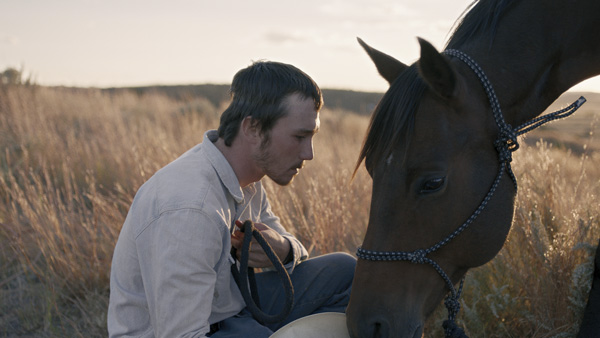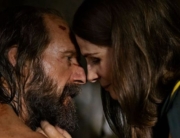For beautiful, intimate moments, few films at Cannes this year were in the same league as The Rider, the second feature by Beijing-born, Denver-based director Chloé Zhao. And by intimate, I don’t mean provocative. (That type of fare turns up annually here, and this year that would be François Ozon’s looney Amant Double.) Take the mesmerizing sequences between a young cowboy, Brady Blackburn (played by Brady Jandreau), and an untamed horse, and later, the same cowboy and his best friend. In the former scene, we watch as Brady calms the skittish horse in real-time; he’s the real-deal horse whisperer.
Throughout, the director seamlessly blends documentary with a narrative based on real-life individuals, the Jandreau family, and actual events. The film is structured straightforwardly, with the characters speaking in their own voices; it’s the most fully convincing and complex direction of a nonprofessional cast this year at Cannes.
Zhao’s first film, Songs My Brothers Taught Me, also screened at the Directors’ Fortnight, a counter program to the main competition. Both are set in the exotic (for the movies) South Dakota—the Pine Ridge Reservation, to be exact. While Songs conveyed a heavy state of resignation among a Lakota Sioux family—to alcohol, drugs, and unemployment—the new film’s themes are more layered and richer, with a wider variation of tone.
An emerging star on the rodeo circuit, 20-year-old Brady (Brady Jandreau), a Lower Brulé Sioux, has been making a steady recovery after an April 2016 rodeo accident in which a horse smashed his skull (which actually happened to Jandreau). His brain had undergone internal bleeding, and he was in a coma for three days and now has a metal plate where he was injured. However, it’s the psychological rather than the physical impact of the accident that concerns Zhao.
Brady’s recovery comes with his doctor’s warning: he can never ride again. One sign of the horseman’s determination, or stubbornness, is depicted early on: on his own, he removes the staples along the incision on the top of his head, after downing painkillers. His pals joke around, calling him Frankenstein, and as the film moves on, his hair grows back, covering his scar.
He lives in a mobile home with his unemployed father (Tim Jandreau), who has been gambling away money, and his 14-year-old sister, Lilly (Lilly Jandreau), who has Asperger’s. (The mother died a few years earlier.) Because he no longer makes his living from the rodeo circuit, Brady begins working part-time as a cashier and janitor at a big box store, the only job with his skills set outside of the corral. Though he won’t ride professionally, he reasons that doesn’t mean he can’t do non-riding work. So he begins training horses, but even that could pose a danger, as he has partial complex seizers—his hand can’t keep up with his brain signals—and his right hand can’t always release its grip. His quest becomes, quite simply, to find his purpose now that he can no longer remain a cowboy.
There’s a strong sense of community among these rodeo riders for one of their own, Lane Scott (played by the real-life Scott), another rising rodeo champion. He was paralyzed in an accident and only communicates with his left hand forming letters, and Brady learns this new way of communicating. On the surface, Brady and his mates are lanky, laconic men of few words—the Gary Cooper image of a cowboy—but with emotional intelligence. They are like characters out of a Sam Shepard play, except they allow themselves to be vulnerable and express emotion—at least privately, in Brady’s case. The hospital scenes in which Brady holds the reins while Scott, on a saddle, goes through the motions of horseback-riding are among the most sensitively rendered between two men.
Additionally, The Rider brings a dimension that’s organic to the story by featuring underrepresented populations. Lily and her autism are matter-of-factly woven into the story, and Brady and his cowboy buddies might identify as white, Native American, or both; it’s beside the point. And the film is gorgeously photographed, often set late in the day during magic hour. This is the world of the isolated plains as seen through Brady’s eyes.
Moving and modest, The Rider was one of the highlights of the festival.







Leave A Comment